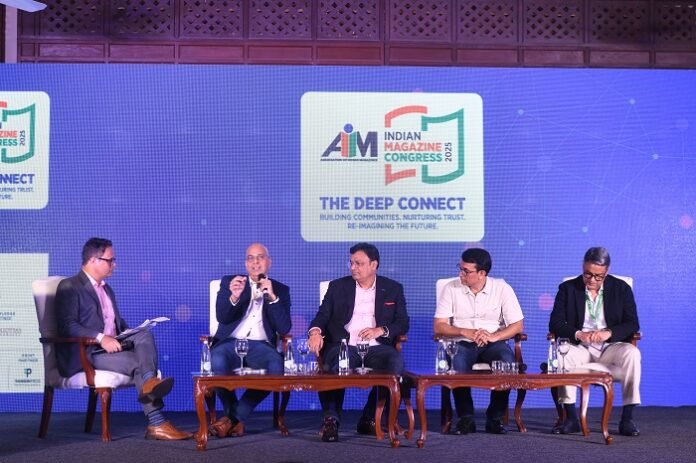
The Association of Indian Magazines (AIM) organized the 14th Indian Magazine Congress 2025 at Delhi’s The Imperial hotel on 8 August with the theme The Deep Connect – Building Communities. Nurturing Trust. Re-imagining the Future.
The congress featured an intriguing panel discussion on ‘What modern marketers can learn from magazine storytelling,’ moderated by Ruhail Amin, senior editor, BW Businessworld.
Amin started with a focus on the emotional resonance and well-crafted narratives of Indian magazines. Avinash Pandey, director, Laqshya Media Group recalled how magazines such as Manohar Kahaniya, Sarita and India Today were subscribed to at home during his growing-up years in Bihar in the 1980s. He said magazine publishers need to clearly define who they are addressing if they want to survive.
Riyad Mathew, chief associate editor and director of The Week, referring to the coverage around Operation Sindoor, said if brands are interested in a fake audience or an audience that consumes fake news, they are more than welcome to advertise on those platforms. “The credibility of print is something we are all really proud of,” he said, adding that exploratory or in-depth journalism in magazines invites more engagement from readers compared to traditional news in newspapers.
Manish Nagar, director – business development India at Triton Digital, said magazines should look at multiple channels of promotion, such as YouTube channels, podcasts, and a presence on social media platforms. Magazine publishers also need to focus on monetization of content.
Rajiv Dubey, VP and head of media, Dabur India said the company has stood the test of time across generations because, as a brand, it has told the story about immunity, well-being and living a good life. A product evolves to become relevant to a current set of consumers in their own format, whether it is print or digital. The format in which a story is told will keep evolving, but storytelling will remain, Dubey said, citing the example of Caravan, which has both in-depth journalism and a good curation of stories.
Pandey said if a brand marketer asks the right questions to a media company in a constructive manner, he is likely to get the right solutions to his problems.
Mathew said there are three types of readers – the first ones are in a hurry and need a quick AI summary to keep themselves updated. The second requires a slightly more detailed round-up of events and happenings, but wouldn’t like to go too deep. The third type is a true lover of reading and loves to read long-format descriptive journalism.
“At The Week, we cater to all three categories,” he said, adding that human intervention, and the use of feelings and emotions to add depth are all aspects of exploratory journalism.
Nagar said there is a need to educate publishers about podcasting and how well it is working in other markets. “We need to distribute podcasts on all platforms such as Spotify, Google Podcasts, Apple Podcasts, and JioSaavn,” he said, adding markets such as the US, Germany and various Asian nations need to be targeted to make a huge chunk of money.
Dubey said every type of content has a place and appeals to different sets of people. Publishers should, thus, focus on content strategy and storytelling formats as nothing is right or wrong.
Mathew said niche content has a niche audience. He explained the different forms of content with an analogy to different forms of cricket – while T20 and one-day cricket can be played by everybody, test cricket is not everyone’s cup of tea. Test cricket separates the men from the boys, he said, adding magazines are in a similar space.
While youngsters and junior editors are keen on digital content, the senior or more experienced editors vote in favor of brand building, which leaves a lasting impact on readers, he said.
Dubey said advertisers book space in ABP’s Durga Puja specials months in advance due to their strong focus on storytelling and long-form journalism. While newspapers have become a destination for premium products such as iPhone and automative companies, ads in magazines keep in mind the look and feel of the products and the high quality of the paper. High-end watch companies always advertise in magazines for these reasons, Dubey said.
He talked about shops on rent for periodicals, magazines and comics in cities such as Delhi and Lucknow in the 1980s and 1990s. At just Rs 10 per month, these shops would allow customers to rent any number of magazines, he said, adding this kind of magazine ecosystem needs to be revived today.
Pandey said at the end of the day, everyone is selling a punchline, whether it’s the marketers and publishers. Some lines, such as ‘Thanda matlab Coca-Cola‘, reach iconic status due to their nuanced storytelling and multicultural appeal.
Dubey said survival is very hard and magazine publishers need to talk to new consumers and look at new markets. True lovers of long-form storytelling will always go to magazines for their credibility.















